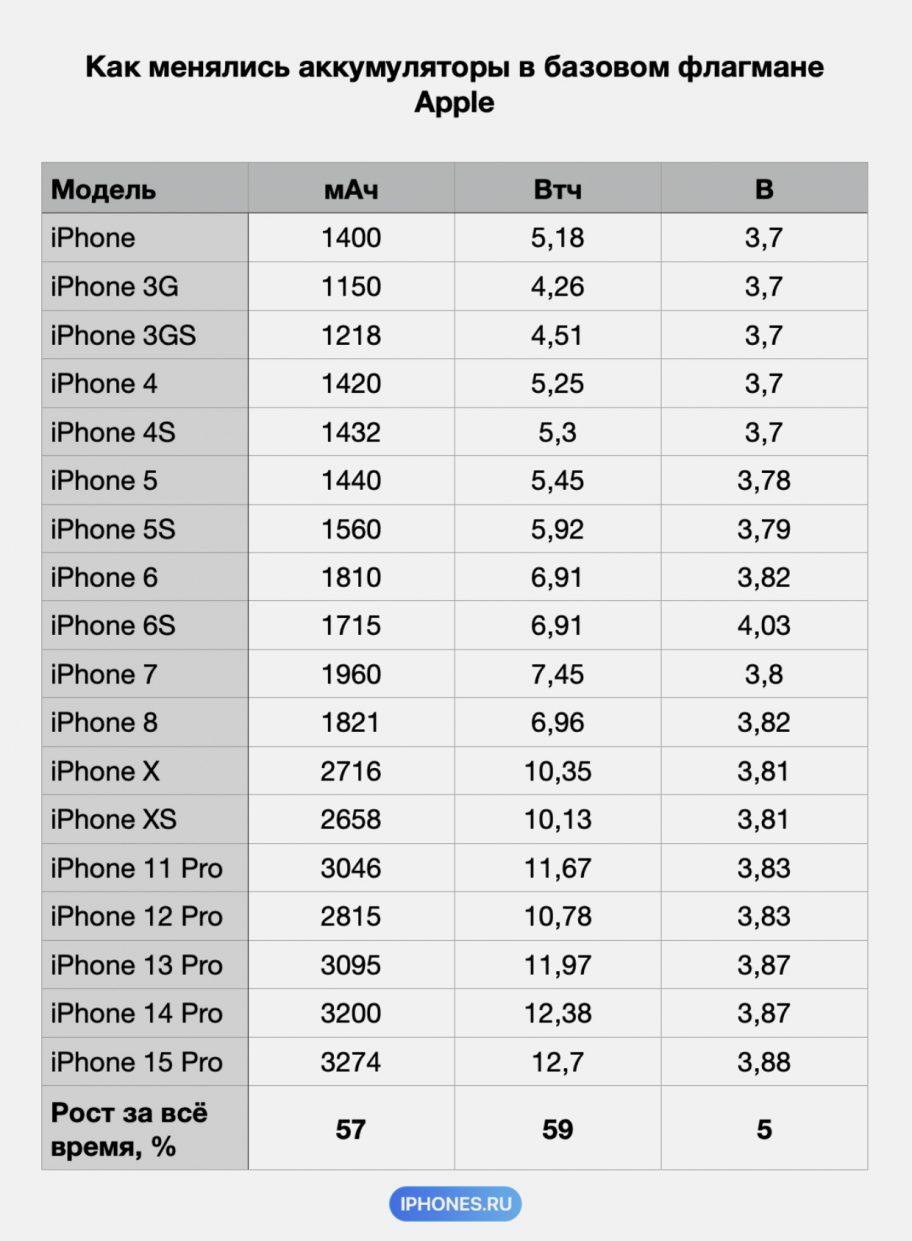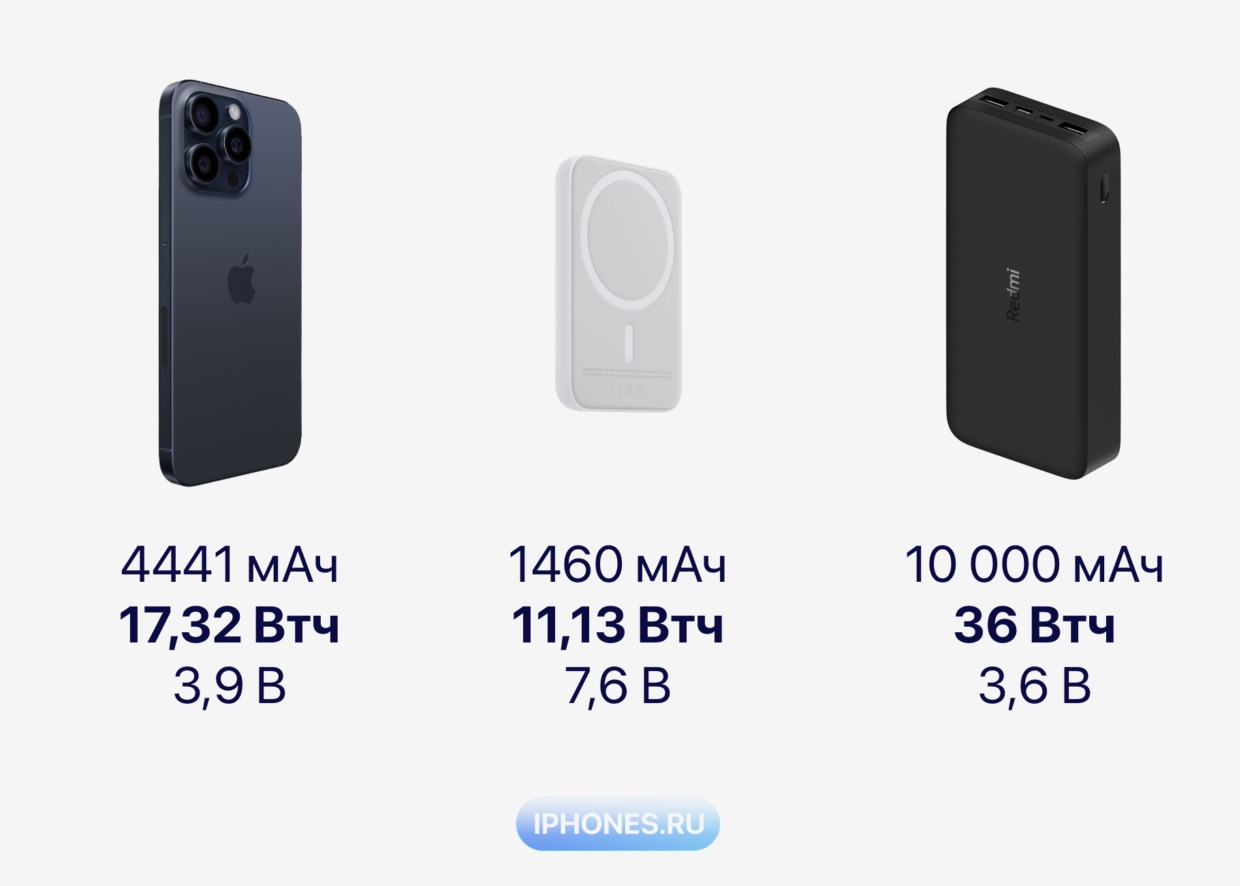Year after year I see the same mistake among professional journalists and bloggers.
For some reason, they rate the battery capacity of the iPhone, Apple Vision Pro, and MacBook using something as stupid as mAh. Yes, stalkless.
But in those same reviews, Apple is judged for the fact that the company never talks about the characteristics at the presentation, in the documentation, or on the website. It simply states: “Here is a battery for the whole day or 29 hours of video streaming.”
We agreed with the notion that marketers avoid precise metrics because they focus on the user experience rather than competing on abstract metrics.
But by that logic, we wouldn’t be told about the 120 Hz ProMotion screen frequency, wouldn’t be shown the difference between 12 MP and 48 MP, wouldn’t be told the number of cores in the GPU and the number of operations in the Neural Engine on the iPhone. But Apple does this every presentation.
The fact is that the problem is so technical that Apple was too lazy to explain. Although the answer is here, on a surface.
Below we will look at a couple of examples and understand what the essence is.
On paper, the MacBook Pro 16 and iPad Pro 11 batteries are the same. In reality, the difference is three times
The other day I wondered what size the battery was in the 11-inch MacBook Air and how it compares to the current iPad Pro 11 and MacBook Pro 16. I dug up some unexpected details.
Take a look at the specs of three Apple devices.
• MacBook Air 11 (2015): powered by a 5110 mAh battery
• iPad Pro 11 (M4): 8340 mAh battery on board.
• MacBook Pro 16 (M3 Pro): has a battery capacity of 8690 mAh.
The conclusions that emerge are strange.
Despite its significantly smaller size, the iPad has a larger battery than the MBA 11 once had, although it shouldn’t consume significantly more power: progress, after all.
The MacBook Pro weighs 2.14 kg versus 0.44 kg for the iPad Pro, its screen is exactly twice as large, and its graphics cores are more power-hungry – the entire system consumes significantly more energy and the batteries simply cannot be the same capacity.
If you take all the devices apart, everything falls into place. The batteries are really completely different in size, on the MacBook Pro it is much larger than on the iPad Pro and MacBook Air, and on the latter two it is very similar.

And there is that one characteristic that puts everything in its place. Only it has meaning in this context and will be a unifying indicator. Energy capacitymeasured in Watt/h.
Look:
• MacBook Air 11 (2015): 38.75 Wh
• iPad Pro 11 (M4): 31.29 W/h
• MacBook Pro 16 (M3 Pro): 99.6Wh.
With this characteristic, it is already easy to conclude that processors and screens have become more energy efficient, and why the battery in the large MacBook allows it to work three times longer than the iPad.
Briefly about variables. mAh ignores discharge rate

The thing is that capacity can be designated by both units of measurement: mAh and Wh. However, in the context of mobile electronics, the Wh indicator has always been more objective, which is formed on the basis of power (W) multiplied by time (hours).
This is because Power, W) calculated by multiplying voltage (V, Volt) on current strength (A, Ampere), while the mAh indicator takes into account only the current strength (A), ignoring voltage (V)which determines how quickly the battery can discharge.
The secret is that iPad and MacBook batteries differ in voltage (V). In laptops it is always higher, and in iPad it is low and close to smartphones.
And here we come to the answer as to why it is impossible to rely on the mAh indicator even between two generations of smartphones, not to mention different classes of devices.
How the voltage changed in all iPhones. Literally different types of batteries


To see the trend, I analyzed the changes in all three basic iPhone battery metrics from year to year.
This table clearly shows that almost every year the battery density relative to the indicator mAh grew.
A noticeable jump happened when Apple released the iPhone 6S. People were wondering why, with a reduced battery capacity (1715 mAh against 1810 mAh in the iPhone 6) and a more powerful processor, the stated operating time remained the same.
There was no secret: the battery capacity remained the same, it was just that the maximum voltage limit increased (4.03 V against 3.82 V) and when measuring power in Wh, the indicator is literally the same as in the iPhone 6 (6.91 Wh).
At the same time, the new processor was more energy efficient and used less battery power under the same normal load. As a result, comparing them by mAh was as incorrect as comparing iPad and MacBook batteries.
At the same time, over 17 years, the voltage gradually increased by 5%. It changed by a hundredth of a share, and sometimes remained the same, but this difference ultimately showed that the basic flagship model added 57% in its capacity if you look at the mAh indicator, and 59% if you focus on Wh.
For the same reason, the mathematics of external batteries does not work

If you’re wondering why your 10,000mAh battery can’t charge promax just once, then here is the answer. Battery manufacturers are deceiving you.
It’s not that there’s a big loss of capacity, it’s that you should be looking at the energy capacity in Wh. Power banks typically have a lower voltage than your smartphone, and therefore need more of those milliamp hours to charge it.
For the same reason, people were wrong to complain about the low mAh value of Apple’s MagSafe external battery.
In the review, I also said that, although this figure did not reach even half of the iPhone 13 Pro (1460 mAh versus 3095 mAh), in reality it could charge the smartphone by 70%, because its energy capacity is 11.13 Wh (in the iPhone 13 Pro 11.97 Wh).
Apple MagSafe Battery Review: One of the Best Buys of the Year
Forget about mAh and check only Wh

Basically, almost all batteries now have a voltage of about 3.6 V, so their mAh is the same. But if you see an expensive battery with a low mAh, most likely, its real capacity in Wh is fine
What happens?
Although in charge capacity (mAh) fewer variables, it is a less reliable indicator. The battery capacity of a laptop cannot be applied to a smartphone. And even between two different smartphones, this indicator cannot be compared, since it does not take into account such an important metric as voltage, measured in Voltach.
From voltage (V) depends on a more objective indicator of battery capacity, which is called energy capacity (Wh). Since its calculation also takes into account Current strength (A)i voltage (V) each individual battery, this characteristic makes all batteries equal.
If you take two absolutely identical devices (but with different processors) and at the same time with the same Wh rating in their batteries and measure how long they work, performing the same task, you will know exactly how much more energy efficient one processor is than the other.
If you take two absolutely identical devices (but with different processors) and at the same time with the same mAh rating in their batteries and measure how long they work, performing the same task, when calculating the results you will have to take into account the power voltage (V).
The Wh rating allows you to directly compare different batteries and the energy efficiency of processors or even operating systems in different devices.
Now you know what to expect mAh in advertising, either batteries or smartphones are not worth it. Before judging how long a new device will work, first of all check its most important indicator, Vtch.
Source: www.iphones.ru


